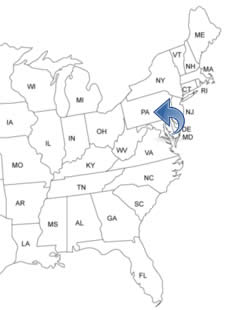PENNSYLVANIA PEOPLE SEARCH!
- ✔ Contact Info
- ✔ Phone Numbers
- ✔ Criminal Records
- ✔ Income Info
- ✔ Neighbors
- ✔ People's Age
- ✔ Property Ownership
- ✔ And Much More
Philadelphia, Pennsylvania
Philadelphia is located in the south-eastern part and is the largest city in the U.S. State of Pennsylvania. Philly. Philadelphia, the birthplace of America. Philadelphia was the meeting place for the Founding Fathers of the United States, who signed the nation's Declaration of Independence on July 4, 1776, and the Constitution on September 17, 1787. There are many national historical sites that are related to the founding of the United States. The city is also known for its arts and culture and Philadelphia has more outdoor sculptures, and other public art, than any other city in the USA.
To See And To Do In Philadelphia
- Wanamaker Organ
- National Constitution Center
- Independence Hall
- Philadelphia Museum Of Art
- Philadelphia Flyers Hockey Team
- The Franklin Institute Science Museum
- The African American Museum
- Liberty Bell Center
- Carpenter's Hall
- Congress Hall
- Atwater Kent Museum Of Philadelphia History
- Pennsylvania Academy Of the Fine Arts
- Academy Of Natural Science
- The Mütter Museum
- The Comcast Center
- The Please Touch Museum
- Franklin Court
- The Philadelphia Orchestra
- Independence Seaport Museum
- Fairmount Park
- Rittenhouse Square
- Declaration House
- Reading Terminal Market
- The Gallery At Market East
- Schuylkill River Park
- Eastern State Penitentiary
- Betsy Ross House
- Elfreth's Alley
- The Italian Market
- Wagner Free Institute Of Science
- Philadelphia Zoo
- The Morris Arboretum Of The University Of Pennsylvania
History Of Philadelphia - Timeline
In 1609, European settlers came to the area. Trading posts and farms were built. The settlers were farmers and they focused on growing enough food to feed themselves and their families.
In 1646, the first church was built by Swedish settlers and in 1677, the Swedes built a second church. In 1681, the Province of Pennsylvania, also known as Pennsylvania Colony, was founded by William Penn. In 1682, the Philadelphia area was included in William Penn's charter for Pennsylvania and the first brick house was erected. After that William Penn bought land from the Swedish settlers, Philadelphia was founded and more streets were built in the town.
In 1690, the first paper mill was established. In 1698, the Religious Society of Friends, Quakers, built a meeting house and the first public school was established in Philadelphia.
In 1700, about 2500 people were living in Philadelphia, mostly Swedes, Dutch, English, Irish and Germans. In 1719, the first newspaper was published.
In 1723, Benjamin Franklin arrived and applied for a job as a printer. In 1731, the Library Company of Philadelphia was founded by was founded in Philadelphia by Benjamin Franklin and others. In 1732, the Philadelphia Hospital was established.
In 1736, Benjamin Franklin founded the Union Fire Company. In 1751, Benjamin Franklin and Thomas Bond founded the Pennsylvania Hospital. It was the first hospital in the United States. In 1752, Benjamin Franklin demonstrated his lightning rod to protect buildings in the event of lightning strike.
In 1753, the Independence Hall was completed. In 1766, the first permanent theatre house was built. In 1770, Carpenter's Hall was built.
In 1775, the United States Postal Service was founded in Philadelphia and Benjamin Franklin was elected as the first Postmaster General of the United Colonies.
On July 4, in 1776, the Declaration of Independence was adopted. In 1777, the British invaded Philadelphia. The occupation lasted for ten months. In 1783, the Bank of North America opened. The same year, a Yellow Fever epidemic in the city is believed to have killed more than 5,000 people. The Yellow Fever was for many years a big problem in the city.
On September 17, 1787, the Constitution was adopted in Philadelphia. In 1793, a new Yellow Fever epidemic killed more than 4,000 people. In 1797, 1798, 1799, the Yellow Fever killed about 6000 people.
In 1800, there were 67,787 people living in Philadelphia and its contiguous suburbs. In 1801, the United States Navy Yard was established. In 1809, the Olympic Theatre was built.
In 1816, gas as an illuminant was introduced and private residences in Philadelphia was lighted by gas. In 1827, the Mechanics Union of Trade Associations was founded. It was now a functunal American trade union. In 1828, the Arch Street Theatre opened. In 1829, the Philadelphia Inquirer was founded.
In 1832, rails were laid in the city. Horse-power was used but after six months a locomotive engine was introduced. In 1857, the Academy of Music opened. It is the oldest grand opera theatre still used for its original purpose in the USA. In 1858, a streetcar line was established in the city.
In 1865, President Lincoln's body was escorted to Independence Hall. In 1876, the Centennial International Exhibition, the first official World's Fair in the United States, was held in Philadelphia. Alexander Graham Bell presented the telephone there.
In 1884, the Philadelphia City Hall was completed. In 1892, the first free public library was established.
In 1900, more than 1,290,000 people lived in Philadelphia. In 1904, 35 percent of the city's worker, worked in the textile industry. In 1907, the city's first subway was constructed. In 1915, Billie Holiday was born at Philadelphia General Hospital. In 1918, the influenza pandemic the Spanish Flu took over 12,000 lives. In 1946, the first operational electronic computer was completed at the University of Pennsylvania.

